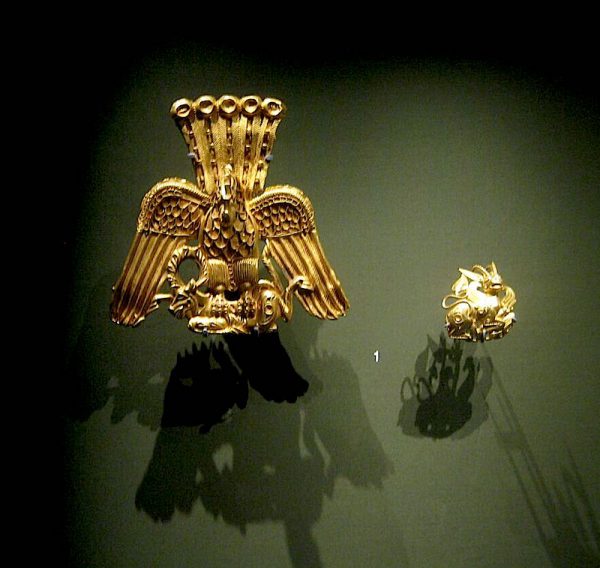The British Museum’s new exhibition, Scythians: Warriors of Ancient Siberia, marks another triumph for the B.M’s policy of allying itself to Russian institutions, the Hermitage Museum in St Petersburg in particular, at a time when political relationships are rough.
Scythian chieftains certainly had a taste for bling – ELS
The bulk of the exhibits, all but a handful of items, come from the Hermitage’s collection of Scythian material, unrivalled anywhere else. In part, this is due to geographical accident. The ancient Scythians roamed through the vastness of Siberia, in modern times always part of Russia, though the title of the show is a little misleading: Scythian finds have also been made elsewhere, for example in North Western China, and in regions of Eurasia that were never at any time Russian-ruled.

In addition, almost the first person to make a systematic collection of Russian objects was none other than the greatest of Russian tsars, Peter the Great, and the many spectacular gold objects featured in the show come from the collection that he formed. In collecting and preserving these things, Peter was, paradoxically, an exemplary figure in the European Enlightenment – unafraid to make an unprejudiced examination of cultures other than their own. Later, it was Russian archaeologists who played in a leading role in the scientific excavation of Scythian sites.
For a Western audience, this show is a perhaps never-to-be-repeated opportunity to have a close look at a magnificently, perhaps terrifyingly exotic world, as far from modern ideas about the civilized as it is possible to get, yet capable of producing objects of marvellous beauty. Unlike the world of the Ancient Greeks, with whom the Scythians were often in contact, it produced no great literature – the objects one sees at the B.M. have of course attracted a good deal of modern interpretation, but essentially they have to speak for themselves. There are indeed ancient texts about Scythia, written by contemporaries, but these are the testimony of witnesses who were, in the most literal sense, outsiders.
For the contemporary visitor, the immediate reaction to the exhibition is, no doubt, human nature being what it is, to ’go for the gold’. The show offers a glittering array of solid gold objects – Scythian chieftains certainly had a taste for bling. The majority of these are items for self-adornment, though there are also weapons and drinking vessels. There are splendidly grand belt buckles, bracelets and torques, and plaques to be sewn onto clothing. In a nomadic society, your wealth, in the most literal way, travelled with you. The only time it stopped travelling was when it was sealed up in your grave.
Scythian goldsmith’s work is simultaneously both barbarous and refined. The animal forms the Scythians loved come from acute observation of the natural world, but yet cannot be described as
‘naturalistic’. They twist and turn and interlock. A predatory beast, attacking another animal, will have a fierce little bird’s head at the tip of its tail.
Accompanying the gold ornaments is a selection of normally perishable items preserved for us to see now by the permafrost of some regions of Siberia. There are headdresses, shoes, also garments made of fur. And there are, too, fragments of bodies, severed human heads, pieces of heavily tattooed human skin.
One minor puzzle left unsolved by the catalogue is this. Wounds to these exhibited body parts indicate that those they represent here died violently, for example, by savage blows to the head. Yet they seem not to be relics of the defeated, These Scythian chieftains made their way, after their violent deaths, to richly furnished graves.
And now they return in person to haunt us, as relics in more than one sense of sophisticated savagery, in the lofty spaces of the British Museum.
Scythians warriors of Ancient Siberia – British Museum 14 September 2017 – 14 January 2018 – £16.50, Members/under 16s free

